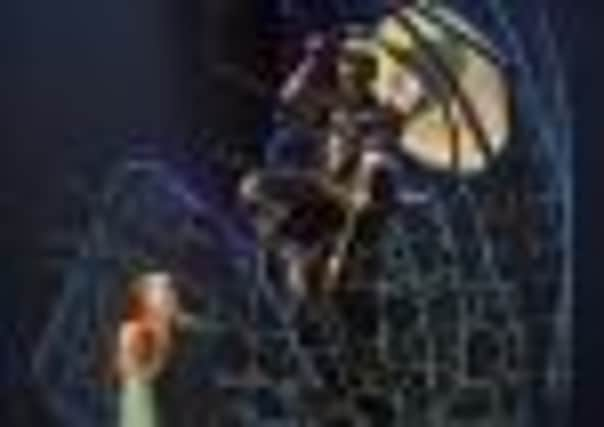Dance: Choreographer David Nixon on his Beauty and the Beast


David Nixon was standing in a dressing room having his costume fitted when he realised he knew more about the clothes he was wearing than the person designing them.
Back then, Nixon was a young dancer with the National Ballet of Canada, keen to show off what his body could do, not hide it behind swathes of material. Today he is artistic director of Northern Ballet, and equally keen to show off his dancers – and the movement he creates for them – in a favourable light. Which is why, as well as choreographing and directing most of Northern Ballet’s shows, Nixon also designs all the costumes.
Advertisement
Hide AdAdvertisement
Hide Ad“I used to go into fittings when I was a dancer, put on a costume and say to the designer, ‘Do you know what movement I’m doing?’ ” recalls Nixon. “And the designer would say ‘no’, so I’d show them what I needed to do, and explain that it wasn’t going to work in that costume. Then they would go back and redesign it. That’s what started me thinking that I actually had an opinion about costumes, and how they should function.”
When Nixon moved from dancing into choreography, financial constraints in the early days led him to design the costumes himself. Eventually, it became a fundamental part of his creative process, especially with Northern Ballet’s latest show, Beauty and the Beast.
“I realised that not only did I enjoy designing costumes, but I actually visualised how the dancer would look, and that influenced quite a bit how I choreographed. I got a whole sense of how the movement would flow, because of the type of fabric the dancer would be wearing. With Beauty and the Beast in particular, once we’d started putting the costumes together, it helped me see what I could do with the characters and how I could move the scenario forward.”
Over the years, Nixon has created some beautiful outfits for his dancers, but with Beauty and the Beast he has really excelled himself. So much so that the company held a fashion show in its Leeds headquarters to show off his creations. Heavily inspired by haute couture, Nixon has dressed Beauty’s troublesome sisters in outlandish catwalk fashions, and even the heavies who signal the family’s fall into poverty are sharp-suited.
“If the sisters are such high-end shoppers, then the men who come to collect the debt should look like they’ve come from Gucci, not like they’ve just come from the neighbourhood removal company.”
Best-dressed of all is Prince Orian, the narcissist enthralled by his own reflection. In Nixon’s version, it is Orian’s self-centredness that leads to his transformation into the Beast, by a group of haute-couture-clad fairies.
“He’s obsessed with himself. At the start, we see Orian looking in the mirror, and his manservant can’t even fix his clothing without being pushed aside so he can keep looking at himself. The Prince’s friends are also obsessed with him, so they further this adoration. He has absolutely no heart, no interest in anything beyond himself. That’s why the fairies put a spell on him and create a challenge – does he really have anything inside?”
Advertisement
Hide AdAdvertisement
Hide AdKeeping the character moving after the transformation was important to Nixon. Often hidden behind a giant mask and ape-like costume, the Beast isn’t usually known for his agility. Yet in Nixon’s version he takes on a more reptilian form, clearly disfigured yet free enough to execute dynamic choreography. “I didn’t want him to look like the Disney version, I wanted to actually see him for a change.”
Originating in France in the 18th century, the tale of Beauty and the Beast has turned up in various guises, but somehow retains its relevance. According to Nixon, there are aspects of the narrative that ring especially true in today’s celebrity-worshipping culture.
“I think now more than ever we have this obsession with how people look,” he says. “And also this belief that how you look on the outside is who you are inside. When I grew up there were bodybuilders and there were normal men – and that was it. So as dancers we didn’t lift weights, because we didn’t want to be a bodybuilder. Today you have ‘physique building’ so there’s a middle ground, and most young men are in the gym, because the expectation is to have a six-pack.”
The excessive over-spend which causes Beauty and her family to lose their home, also has resonance for modern audiences. One minute Beauty’s sisters are coming home from the shops laden with bags, the next they’re in ruin.
“There have always been these pressures and debt collectors have always been around, so I’m not saying the show is more relevant than ever, but it’s certainly still as relevant as ever. Even though this is just a fantasy, people do get themselves into debt, they do get their things collected, and it can all be stripped away.”
• Northern Ballet’s Beauty and the Beast is at Edinburgh Festival Theatre, tonight until Saturday.
A PICK’N’MIX SCORE
Inspired by Beauty and the Beast’s French origins, Nixon has pulled together a classical score as recognisable as the tale itself. Rather unusually for a narrative ballet, there is no central composer driving the work along. Instead, Nixon chose Debussy’s Clair de Lune, Saint-Säens’ Danse Macabre and works by Bizet and Poulenc to help create a range of emotions on stage.